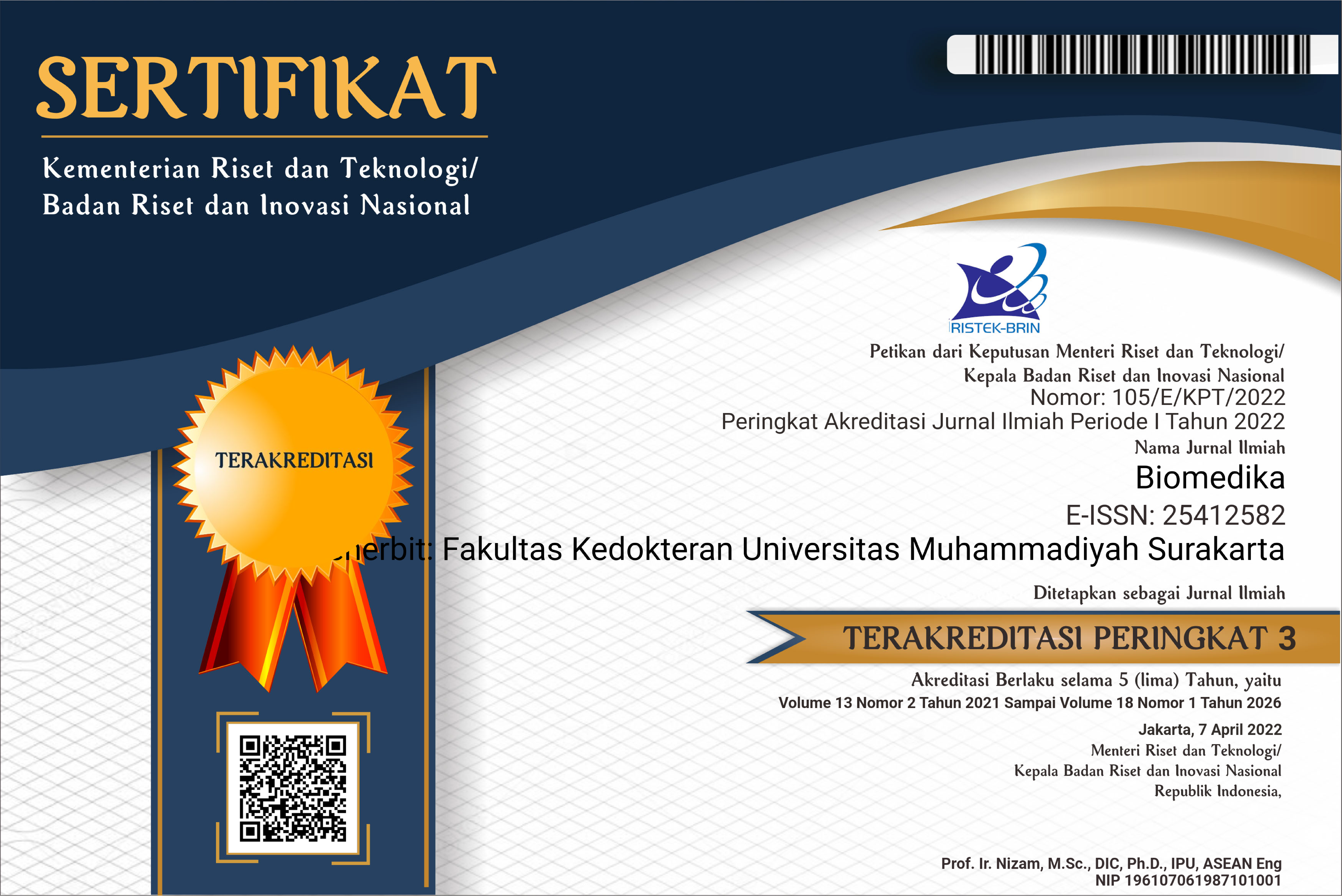THE EFFECTS OF MONOSODIUM GLUTAMATE ON WORKING MEMORY AND ESTIMATED TOTAL NUMBER OF MEDIAL PREFRONTAL CORTEX PYRAMIDAL CELLS OF JUVENILE RATS
Pengaruh Monosodium Glutamat pada Memori Kerja dan Perkiraan Jumlah Total Sel Piramidal Korteks Prefrontal Medial Tikus Remaja
DOI:
https://doi.org/10.23917/biomedika.v15i1.1746Keywords:
MSG, Working Memory, Pyramidal Cell, Stereology, Memori Kerja, Sel Piramida, StereologiAbstract
ABSTRACT
Monosodium glutamate (MSG) is a food additive substance that is widely used as seasoning and flavor enhancer throughout the world. However, MSG at certain dosages is also thought to cause damage to many organs, including prefrontal cortex. The aim of this study was to examine the effects of a range of doses of MSG on the working memory and estimated total number of pyramidal neurons in the medial prefrontal cortex of juvenile rats. A total of 24 male rats aged 4 to 5 weeks were divided into four groups, namely, control (C), T2.5, T3, and T3.5 groups, which received intraperitoneal injection of 0.9% sodium chloride solution, 2.5 mg/g body weight (bw) of MSG, 3.0 mg/g bw of MSG, and 3.5 mg/g bw of MSG, respectively, for 10 consecutive days. The working memory of the rats was examined by Y-maze procedure after the treatment by calculating the alternation percentage. The number of prefrontal cortex pyramidal cells was estimated using stereology physical fractionator method. It has been found that there was no significant difference in the percentage of alternation between C group and all MSG-treated groups, while the estimation of the number of pyramidal cells had a significant difference between C group and T2.5 and T3.5 groups, but not with T3 group. The conclusion of this study was that the administration of MSG at every dosage are not affect the working memory and there was an effect of MSG administration at doses of 2.5 and 3.5 mg/g body weight on the total number of pyramidal cells in the medial prefrontal cortex of adolescent rats.
ABSTRAK
Monosodium glutamat (MSG) merupakan bahan tambahan makanan yang banyak digunakan sebagai bumbu dan penambah rasa di seluruh dunia. Namun, MSG pada dosis tertentu juga diduga menyebabkan kerusakan pada banyak organ tubuh, termasuk korteks prefrontal. Tujuan dari penelitian ini adalah untuk meneliti efek berbagai dosis MSG pada memori kerja dan perkiraan jumlah total neuron piramidal di korteks prefrontal medial tikus remaja. Sebanyak 24 ekor tikus jantan umur 4 sampai 5 minggu dibagi menjadi empat kelompok yaitu kelompok kontrol (C), T2.5, T3, dan T3.5 yang masing-masing mendapat injeksi intraperitoneal larutan natrium klorida 0,9%, 2.5 mg/g berat badan (bb) MSG, 3.0 mg/g bb MSG, dan 3.5 mg/g bb MSG, selama 10 hari berturut-turut. Memori kerja tikus diperiksa dengan prosedur Y-maze setelah pemberian intervensi dengan menghitung persentase alternasinya. Jumlah sel piramidal korteks prefrontal medial dihitung menggunakan metode stereologi fraksionator fisik. Hasil yang diperoleh menunjukkan bahwa tidak terdapat perbedaan persentase alternasi yang bermakna antara kelompok C dengan kelompok yang diberikan MSG, sedangkan perkiraan jumlah sel piramidal tikus terdapat perbedaan yang bermakna antara kelompok C dengan kelompok T2.5 dan T3.5, tetapi tidak dengan kelompok T3. Kesimpulan penelitian ini adalah tidak terdapat efek pemberian MSG terhadap memori kerja dan terdapat efek pemberian MSG dosis 2,5 dan 3,5 mg/g bb terhadap jumlah total sel piramidal korteks prefrontal medial tikus remaja.













